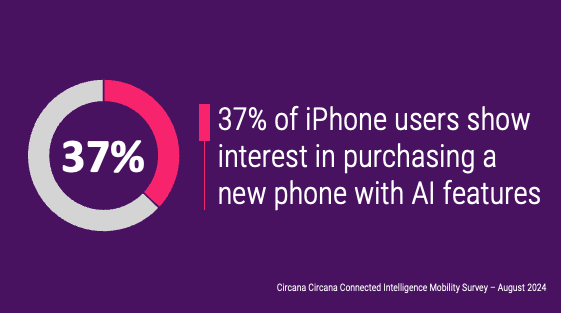
Apple unwraps the much-awaited iPhone 16 Series.
Apple’s new iPhones officially launched last week, and while the excitement was palpable, there were few surprises. Unlike in previous years when Apple obsessively guarded product details, many of the key features of the iPhone 16 series were already circulating in leaks. Here’s Circana’s quick take on the new iPhone 16 series and its potential performance in light of current market trends and consumer dynamics.
Incremental hardware upgrades: As expected, the iPhone 16 models come with faster processors, enhanced camera capabilities, and improved battery performance compared to last year’s versions. Apple typically reserves major design overhauls for every four to five years, so it’s not entirely fair to criticize the relatively minor hardware updates (like the new “Camera Control” feature). That said, most iPhone users don’t upgrade based on flashy new features but rather follow a predictable upgrade cycle—typically every four years. With a large base of iPhone 12 users now due for a replacement, the iPhone 16 is likely to see strong performance simply from this natural cycle.
Siri is not getting smarter right away, but that’s fine: One surprise was how little Apple highlighted AI in the iPhone 16 launch event. Many expected AI to take center stage, similar to how 5G dominated the iPhone 12 reveal. However, Apple’s new AI features, including improvements to Siri, won’t roll out until later through software updates in October, with even more advanced features (like Visual Intelligence, Genmoji, and OpenAI integrations) coming later. While this may seem like a missed opportunity, most consumers aren’t as concerned with AI in smartphones as the tech industry might believe. Circana’s August mobility survey showed that only about a third of smartphone owners are genuinely interested in AI-powered devices, with iPhone users showing slightly more interest (37%). However, AI features remain a low priority, and most users don’t even know what AI capabilities their phones already have. In our survey, only a single feature, smart assistants like Siri, Google or Alexa, enjoyed a 50% awareness rate. And only two features, smart assistants and smart battery management, reached a 30% interest level, proving how indifferent most consumers are for AI features on smartphones.
The adoption curve for the iPhone 16 is likely to mirror the iPhone 12’s: many consumers bought the iPhone 12 not for 5G but because their older devices were due for a replacement. AI, much like early 5G, still lacks that "killer app" to drive mass adoption.
Minimal risk of churn to Android: Apple may be trailing Android competitors in certain hardware specs and generative AI integration, but this hasn’t significantly impacted customer loyalty. While some Android flagships boast foldable screens or 120 Hz refresh rates (still missing from the entry-level iPhone 16), most iPhone users aren’t swayed by these features. Circana data shows Apple’s loyalty rate among U.S. postpaid customers hovers around 95%, and prepaid users aren’t far behind at 85%. Even with incremental improvements, the iPhone 16 will appeal to a large group of aged iPhone users due for an upgrade, particularly with the aggressive carrier deals on offer.
Entry-level iPhone on steroids: Apple’s decision to pack its entry-level iPhone 16 with features typically reserved for the Pro models, like Camera Control and the new AI features, shows a smart strategy, especially in a time of economic uncertainty. With consumers facing tighter budgets, this move makes the standard iPhone 16 a more attractive option. The threat of cannibalization to the Pro models is minimal, as U.S. Pro buyers typically purchase with significant carrier subsidies.
Carrier promotions to drive upgrades: As expected, major U.S. carriers have launched aggressive promotions for the iPhone 16, with offers that make even the top-tier Pro models essentially free—provided customers meet certain criteria, like trading in older devices and subscribing to premium plans. The difference in 2024 is that carriers have also raised prices on their legacy plans, creating additional incentive for users to upgrade to premium plans that come with bundled perks like free content subscriptions. This year’s promotions are particularly notable for AT&T, which is pushing hard with its fiber bundle, offering a free iPhone 16 Pro Max for new fiber customers. Boost Mobile also stands out, offering the iPhone 16 Pro Max with no trade-in required, though users must sign up for its $65/month Boost Infinite plan.
In summary, the iPhone 16 series may not boast groundbreaking innovations, but it doesn’t need to. With a large base of iPhone 12 users due for an upgrade, aggressive carrier promotions, and a well-timed product lineup, Apple is poised for a successful Q4, even without AI taking center stage.


